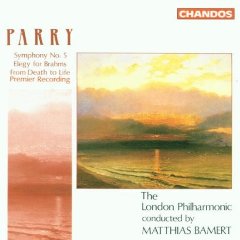Parry – Symphony No.5 – From Death to Life – Elegy for Brahms (1991)
Parry – Symphony No.5 – From Death to Life – Elegy for Brahms (1991)

Symphony No. 5 in B minor 'Symphonic Fantasia 1912' 26:51 1 I Stress - Slow - Allegro - Tempo 1 7:06 2 III Love - Lento 5:59 3 III Play - Vivace 4:46 4 IV Now - Moderato 9:00 From Death to Life Symphonic Poem in two connected movements 16:34 5 I Via Mortis - Lento 8:40 6 II Via Vite - Slow alla marcia 7:54 7 Elegy for Brahms in A minor 13:19 Maestoso espressivo - Largamente - Tempo primo London Philharmonic Orchestra Matthias Bamert – conductor
Parry struggled to find his voice at a time when English music had been moribund since Handel's era. Just as he was maturing, Elgar sprang out of the blue and more or less eclipsed him. Undoubtedly Elgar was the greater composer, so it was very tough on Parry. Not that Parry would have worried one bit - he was too much of a collegiate person to worry about his own ego. Formerly described as second rate, we now have good recordings and can reassess what these critics said. I think they are very wrong. A very individual voice emerged over time. There is an Elgarian sweep and nobilimente - and who came first? I have to conclude that Elgar owes a lot to Parry. The fifth is his last symphony(1912). The thematic material is very strong, very Parry (he knew how to write a tune - see Jerusalem) and he knows exactly how to build and relax climaxes, and develop his material. He certainly does not have the mastery of orchestration that Elgar or Strauss had at this time but it is certainly not amateur or ineffective. Perhaps in the 3rd movement there is too much of the landler which perhaps shows he is still too closely tied to German models for an English composer. The beginning of the last movement, with its chamber quality, shows he was not quite oblivious to modern orchestration. In the end, it is the sheer quality of thematic invention and his handling of this material that makes this a fine symphony. When Sir Adrian Boult was about retire, EMI said he could record anything he liked. He chose this symphony. Why? A prominent (I will not say distinguised) critic reviewed the LP and said the score ought to be stuck back on the dusty shelf whence it came. Listen to this CD and see how misguided he was. The symphonic poem From Death to Life (1914) dates from two years later. This a based on a portentious, memorable and elegiac brass theme and its extension. It is noble and affecting and very Parry, exemplifying again his fecundity with thematic material. This is a movement you always want to go on and on. The Via Vitae is Elgarian and British Empire. Maybe this did suggest life to the British in 1914. The final piece on this disc is the Elegy for Brahms (1897). This is quite exquisite and is a small masterpiece, though not like Brahms. The opening is so intensely expressive as to recall Schoenberg's Verklarte Nacht. The ending is quite magical, such is his control of our emotions. The performances by the LPO under Matthias Bamert are superb and the recording is outstanding. --- Dr. R. G. Bullock, amazon.com
download: uploaded anonfiles mega 4shared mixturecloud yandex mediafire ziddu








